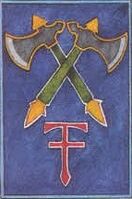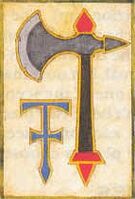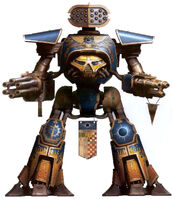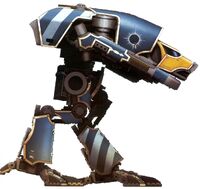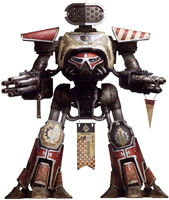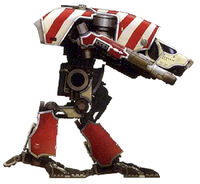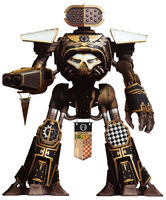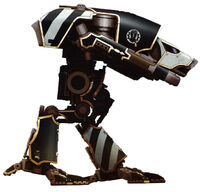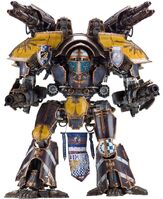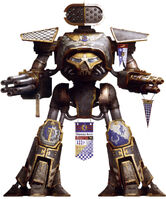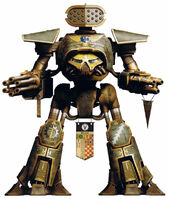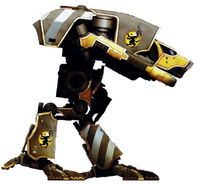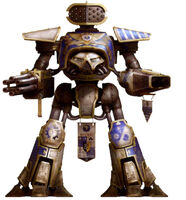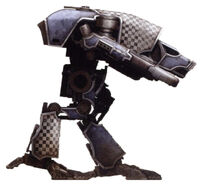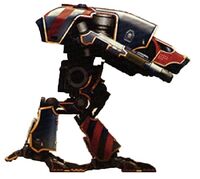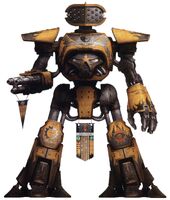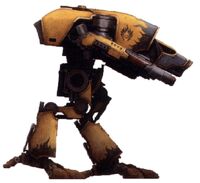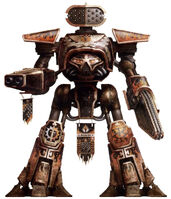"We are all but a weapon in the right hand of the Emperor."
- — Exhortations Principiis Titannorum, Divisio Militaris
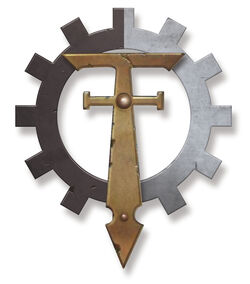
Symbol of the Collegia Titanica
The Collegia Titanica is the division of the Adeptus Mechanicus that operates and oversees the Titans, the colossal Imperial war machines that are the most powerful engines of war in the Imperium of Man. The Collegia is also more rarely known as the Adeptus Titanicus (a contraction of "Adeptus Mechanicus Collegia Titanica") and as the Legio Titanicus in ancient records dating back to the Great Crusade and the Horus Heresy.
Born of the time during the Age of Strife when the first temples to the Omnissiah were being raised on Mars, the Titans are the personification of the military might available to the Emperor of Mankind. Bristling with massive cannons and missile launchers capable of wreaking terrible destruction upon an enemy, they dominate the battlefields of the galaxy and are a testimony to the consummate skills of the Tech-priests of the Cult Mechanicus.
Every Titan is part of a larger unit called a Titan Legion. Each Titan Legion is based on a Mechanicus Forge World and remains under the direct control of the Adeptus Mechanicus, who jealously guard these mighty war machines and have the power to sanction which war zones they will commit their forces to. It is this power that gives the rulers of the Adeptus Mechanicus much of their influence when it comes to determining when the armies of the Imperium will fight. It is a power which is coveted by other factions on Terra -- especially the priests of the Ecclesiarchy, who would dearly love the reliable support of Titans for their wars of faith.
The Titan Legions of the Adeptus Mechanicus are amongst the most powerful military entities within the Imperium of Man. Ancient and implacable, Titans are colossal engines of war, rightly known as God-Machines to the Tech-priests, who revere them as the physical embodiments of the Machine God. Even the smallest class of Titan is mighty enough to destroy an entire tank squadron in a span of seconds or level a city block. Each Titan Legion is its own ancient warrior order inextricably linked to the Forge World (or worlds) on which it is based. The Titan Legions are fierce and proud, each with its own historic alliances and rivalries, and its own unique character that makes it somewhat similar to its counterparts amongst the Chapters of the Adeptus Astartes.
History
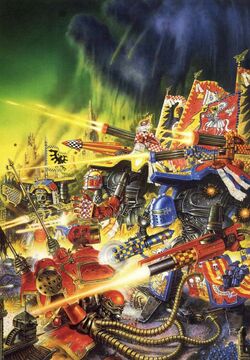
Loyalist Titans of the Collegia Titanica holding the line against Traitor Titan Legions
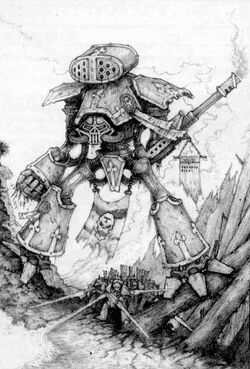
Reaver-class Battle Titan supporting an advance by the Space Marines
One of the most ancient pillars of the Adeptus Mechanicus, the Collegia Titanica operates the mighty Titans, each a bipedal metal giant armed with weapons able to level entire districts, and protected by armour and void shields capable of shrugging off attacks from all but the heaviest of foes. Though few in number compared to the uncountable hosts of the Great Crusade, the Titan Legions fought at the forefront of the Imperium's expansion, carrying the light of Unification to the benighted worlds of Mankind. The so-called "god-engines" of the Titan Legions have served Mankind since long before the Age of Strife, their origins lost in the Dark Age of Technology.
Old Night
During the Age of Terra the human race advanced beyond its ancient pre-industrial past to obtain spacefaring capability. In this ancient time, mankind slowly and painstakingly began to settle the habitable worlds in its own solar system and in the star systems near its homeworld using massive starships capable of only sublight speeds. Mars was one of the first colony worlds to be settled by humanity, if not the first. But during the Age of Strife, interstellar travel and communications became erratic as Warp Storms became more frequent and more intense as the birth pangs of the Chaos God Slaanesh roiled the Immaterium. The use of Warp-Drives and Astropaths to tie together human-settled space became increasingly useless during this time. Billions eventually died as a result of the wars, renegade psykers, daemonic possessions and starvation that ran rampant during this dark period.
Mars eventually found itself cut off from Terra and all the other human-settled worlds during this period, and its leaders could no longer acquire sufficient food or resources to accommodate its large population. Mars was soon consumed by strife as its society drifted into anarchy and a new faith began to spread amongst its people, a religion focused on the technology needed to ensure their continued survival on a world whose carefully constructed biosphere was unravelling before their very eyes. This was the Cult Mechanicus, dedicated to the animistic worship of the Machine God. Under the direction of the Mechanicus' rigid hierarchy of Tech-priests, the cultists set about restoring order to their world. The Legios themselves came into being on Mars during the anarchy of Old Night, when the fabled "Triad Ferrum Morgulus" was established. This trio of nascent Orders consisted of the Legio Tempestus, Legio Mortis and Legio Ignatum, and while all three stood against the horrors of Old Night, from ravening xenos to thinking-machine aberrations, they were just as equally likely to fight one another; for each served the interests of its home Forge above all else, so that throughout the long age of anarchy, rivalries were established that much later would bear bitter fruit indeed. The Tech-Priests of Mars built their first temples to the Machine God and eventually restored order to the Red Planet after the Age of Strife had passed.
The Lords of Terra
When the Emperor of Mankind came to the Red Planet, having brought unity to war-shattered Ancient Terra, the first human colony he encountered was the Red Planet, Mars. Heralded by all those who met him as the Omnissiah, the Machine God Incarnate, some within the Cult Mechanicus were not entirely pleased with this turn of events. A few of these malcontents incited a short and bloody insurrection against those within the Cult who called for an alliance with the Emperor, but eventually the opposition was crushed and Mars and Terra were finally reunited after millennia of separate development by the Treaty of Mars in circa 800.M30. This agreement formally founded the Imperium of Man as an alliance between Terra and the Cult Mechanicus, and granted the latter the autonomy required to maintain their faith even as the Emperor intended to spread his secular and atheistic Imperial Truth across the galaxy. Upon Olympus Mons the Lords of the Red Planet ascended to their place alongside the Imperium of Man, but the Mechanicum would ever remain an empire within an empire, for machine domains other than Mars existed across the galaxy and would in time swear fealty to the Fabricator-General of Mars. In recognition of the fact that the Unification of all humanity could not be achieved without the technological and scientific aid of the Mechanicum, Mars became an ally to Terra rather than her subject. With the massive human resources of Terra and the colossal technical and industrial power of Mars, the Emperor could begin his mighty enterprise of reconquering the galaxy on a firm foundation. Many long-forgotten human-settled planets were liberated and many more worlds were settled anew. Thus began the Great Crusade, and for over the next 200 Terran years the Imperium of Man rapidly expanded across the galaxy.
As the Emperor's hosts pushed ever outwards into the galaxy, casting back the horrors that had gripped the scattered human worlds for so many long centuries, the Titan Legions marched with them. Fighting alongside the trans-human Space Marines of the Legiones Astartes, the elite void-soldiers of the Solar Auxilia and numerous other forces in the rapidly expanding Excertus Imperialis, the Titan Orders came upon other I planets dominated by their long-lost kin, ll Forge Worlds not unlike Mars and ruled by I similar techno-theocracies. A few refused to acknowledge the primacy of the Red Planet and had to be forced to submit, or in some cases were even destroyed. The majority however knew of the Red Planet through the few fragments of archive data and echoes of legend which had managed to survive the Age of Strife, and willingly took their place in the new order.
The Might of the Titan Legions
"No weapon in the arsenal of the Imperium or the Traitor equals the Titan on the battlefield, and a Legion of such war machines can bring any world to its knees. In truth a Titan has only three enemies: folly, hubris and another of its own kind."
- — Grand Master Volkus, Ordo Sinister, Divisio Militaris
The greatest of the newly-discovered Forge Worlds were found to host their own Titan Orders, and while many had developed their own unique and sometimes idiosyncratic cultures, others were found to have organised themselves along a similar line to the original Martian Triad Ferrum Morgulus, suggesting some underlying machine principle or pattern at work, which the Lords of Mars looked upon and found pleasing. Of the lesser Forge Worlds not possessed of the necessary templates, resources or expertise to construct and operate their own Titans, Mars favoured those who swore fealty with such patronage that they might do so.
Within scant decades of the outset of the Great Crusade, the Mechanicum had discovered or founded a score of Titan Orders, and by the turn of the first century of the Great Crusade, the orders of battle by which the Legios arranged themselves had become somewhat codified, and while individual bodies exercised considerable variation in strategy, a degree of standardisation was evident. The Fabricator-General proclaimed that the many Titan Orders should be recognised as a distinct class within the greater corpus of the Mechanicum, that its doctrines, traditions and battle honours might be propagated and preserved for the good of all Mankind. This body was to be known as the Collegia Titanica, and while the Legios themselves would remain subservient to the will of the individual forge lords, it would become a politically influential entity within the emerging structures of the nascent Imperium of Mankind.
The Collegia Titanica came to rate the strength of each Titan Legion according to a complex formula that allotted each a Militaris grade. First tier designations ranged from "primus" to "denarii", with a range of further clausal numerical definitions describing the Legio's specific capabilities, specialisations and other characteristics. Though it rarely told the whole truth, the most obvious measure of a Titan Legion's strength was ever the number of god-engines it could field, with the largest maintaining as many as 200-300, while the smallest might be able to muster barely a dozen. In reality however, the mixture of Titan classes was a far more reliable indicator of potency than raw numbers. Few indeed could field the colossal Imperator-class, while almost all fielded significant numbers of Warhound Scout Titans, the lightest common engine, with the ubiquitous Warlord and the standard Battle Titan, a proven and powerful design which made up the bulk of most Legios' main strength. There were many other classes besides, notably the ancient Reaver and several Warlord variants such as the Nemesis and Nightgaunt and other, rarer chassis whose designs such as the Apocalypse, Carnivore and Komodo were unique.
Many Titan Legions had a particular mix of god-engines they preferred to commit to battle, exemplifying their own specific battle doctrines. Legio Audax, also known as the "Ember Wolves", for example, fielded a large number of Warhound Scout Titans, employing them as fast-moving hunting packs that were fearsomely effective at harrying and bringing down far larger enemy engines. Most Legios however, sought to maintain a balanced and flexible force able to prosecute a wide range of operations and confront many different foes.
Though some Titan Legions used their own vernacular, the Collegia Titanica enforced a degree of standardisation in unit nomenclature. Depending on their role, Titans were fully capable of operating individually, and often did so when supporting conventional ground units. In practice, they were often deployed in formations of anything from two to ten god-engines, but broken into formal units known as a "maniple" comprising five god-engines -- the numeral's' having an occult and numerological signifier of destruction in many numiscantic systems of prognostication favoured by the Omnissian cult. The most senior Titan commander -- or princeps -- was appointed as the maniple's leader and this force was considered sufficient to prosecute all but the most apocalyptic of battles.
The Warriors of the Collegia Titanica
Titan crews rank alongside the elite of the Imperial Navy in the skill and with which they operate their mighty engines of war, although compared to the crews of void-faring warships they are few in number indeed. The princeps is in total command of the Titan via a mind impulse unit, a complex and not entirely understood device that merges body and mind with that of the engine so completely that a princeps controls the Titan's metal form as they would their own flesh. The process is a two-way one however, for each Titan, in particular the more ancient machines, is invested of its own individual anima which is the product of its deeds and its former masters, and which bleeds into the consciousness of the princeps to create a gestalt of the two. So immersive is this connection that should the Titan suffer damage, the princeps feels it as if their own flesh were wounded. Severe damage is likely to cause crippling stigmata on the princeps' body, and should the engine be dealt a killing blow, the cyber-neural feedback is almost certain to kill them.
Assisting the princeps are a number of specialist crew, the exact number and their roles dependent on the class of Titan as well as the doctrines of the parent Legio. These are known as "moderati", and each has responsibility for a different system, such as the sensors or the helm, adding their own oversight towards the mind impulse commands of the princeps. Several of these moderati are stationed at the princeps' side within the "head" of the god-engine, while others are located elsewhere in the Titan's mighty form-the gun moderati, for example, are often stationed in the carapace as near to their weapons as the Titan's complex anatomy allows. In addition, one or more Tech-Priests watch over the god-engine's mighty plasma generator, assisted by a small cadre of servitors. While a lighter class of Titan, such as a Warhound, might have but a handful of crew, a Warlord might have a dozen and an Imperator even more.
Servants of the Collegia Titanica
Not all of a Titan Legion's subjects serve within the mighty god-engines, for many more fight in their shadow. Each Forge World is served by massive cohorts of Skitarii, Scutarii and Secularis, and these are often assigned to provide the Titan Legions with massed ground forces capable of performing the battlefield duties which the Titans themselves are too large to perform. Furthermore, there are those Forge Worlds which, having compacted with subservient Knight Houses, march to war preceded by a fast moving skirmish line of Knight-Lancers and similar classes of walker that bridge the gap between infantry and Titan, engaging enemy vehicles and allowing the Titans to concentrate on the heaviest of enemy war machines, in particular enemy Titans.
It is when an army is to confront an enemy that is itself supported by Titans that they truly come into their own, and this only came about with the outbreak of the Horus Heresy. From the very outset, the Warmaster ensured that as many Titan Legions as possible rallied to his banner and first amongst these was the Legio Mortis -- the "Death's Heads" -- and soon others followed. Traitor Titans saw service in the very earliest battles of the Horus Heresy, including the Istvaan III Atrocity and the Istvaan V Dropsite Massacre. The Collegia Titanica was split asunder by the war and as it spread across the galaxy, the battlefields of the sundered Imperium burned with the staggeringly destructive potential of these mighty god-engines. The battle was never so bitter nor all-consuming however as when Traitor and Loyalist Titans faced one another in open war, the mortal soldiers fighting at their feet as inconsequential as insects and slain by the thousands as unimaginable energies were unleashed.
Horus Heresy
The Great Crusade continued to expand outwards, until the Imperium encompassed nearly the entire galaxy by the early years of the 31st Millennium. At that time, a new and unexpected threat emerged to challenge Mankind's dominance over the galaxy. This was the rebellion against the rule of the Emperor that would be known to later ages as the Horus Heresy. This revolt was instigated and led by the Warmaster Horus, the greatest and most beloved of the Emperor's sons, the Primarchs. The rebellion began with Horus' virus-bombing of those Space Marines whose loyalties to him were suspect on the world of Istvaan III, and soon took hold amongst half of the Space Marine Legions and many of the Titan Legions serving under the command of the Warmaster, until nearly one third of the entire armed forces of the Imperium had sworn their allegiance to the Traitors.
Schism of Mars

Fabricator-General Kelbor-Hal
It is not entirely clear how Horus managed to turn such a significant percentage of the armies under his command against the Emperor, but he was known to be a very skilled and persuasive leader who commanded immense personal loyalty amongst his subordinates. But even before the opening stages of his planned insurrection occurred, he knew he would have to secure the support of the Mechanicus and their superior technology and weapons if he was to defeat the Emperor and conquer the galaxy. Horus won over the loyalty of many of the Mechanicus' Tech-adepts after promising them the lost secrets of ancient Standard Template Construct (STC) technology that had been recovered from the worlds of the recently subjugated Auretian Technocracy by the Sons of Horus Legion.
The climate on Mars was full of discontent during this tumultuous time. There were tense relations between the various Techno-Magi with sporadic outbreaks of espionage and violence being committed against the various forge cities that represented the primary sociopolitical units of Mars. There were even unconfirmed suspicions that the Titan Legions had already secretly chosen sides in case of a potential conflict. Regulus, the Mechanicus' representative to Horus' 63rd Expeditionary Fleet who had already thrown in his lot with the Warmaster's cause, was sent to the Red Planet to secure the tentative support of the Fabricator-General of Mars and the overall leader of the Mechanicus, Kelbor-Hal. Regulus convinced the Fabricator-General of Horus' resolve to support increased autonomy for the Mechanicus against the autocratic rule of the Emperor. As a show of his appreciation for the Fabricator-General's support, Horus provided information to Kelbor-Hal that allowed the Mechanicus to open a repository of forbidden knowledge known as the Vaults of Moravec, which had been sealed for nearly a thousand standard years. The Emperor himself had decreed that the vaults never be opened, for they contained innumerable artefacts of technology that had been fashioned or corrupted by the malign power of Chaos in ages past. But the deal was struck, and the Fabricator-General accepted Horus' proposal and joined forces with the Warmaster, assisting the Traitors with all of the most advanced technology of Mankind at his disposal.
When this repository was reopened, there was all manner of forbidden arcane knowledge and weaponry that had obviously been tainted by the corrupting influence of Chaos stored within. Soon the corruption spread throughout the forge cities and temples across the Red Planet as scrap code -- Chaos-contaminated digital source code that was infected with an arcane computer virus -- infested the logi-stacks and Cogitator (computer) archives of the Mechanicus, causing literal Chaos to emerge in any Cogitator system that was networked to one of its infected counterparts. The Fabricator-General and his Dark Mechanicum allies used this disruption to marshal the strength of their forces, intent on bringing the rule of Mars firmly under their control. Infected by this vicious scrap code, the Titans of the Legio Agravides and the Legio Fortidus met their end when their reactors went critical and exploded, destroying their fortresses and eliminating these once-proud Titan Legions from the roster of Loyalist forces. In later years, this night would become known in Mechanicus legends as the Death of Innocence.
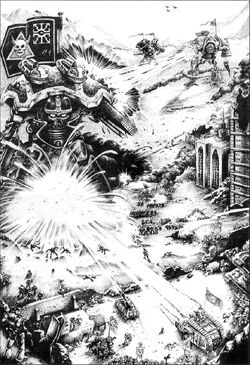
A Warlord-class Titan of the Legio Mortis clashes with the Legio Tempestus
Later histories would record that the first blow of the Martian civil war was struck against Magos Mattias Kefra, whose forge city in the Sinus Sabaeus region was housed within the Madler Crater. Titans of the Legio Magna marched from the southern Noachis region and within minutes had smashed down the gates of Kefra's forge. Howling engines daubed in red, orange, yellow and black, decorated with flaming horned skull devices, ran amok within the high walls of the crater, crushing everything living beneath them and destroying thousands of standard years of accumulated wisdom in a fury of fire. Vast libraries burned and weapon shops that served the Imperial Army troops of the Solar Guard were reduced to molten slag as the indiscriminate slaughter continued long into the night, the Legio Magna's trumpeting warhorns sounding like the atavistic screams of primitive savages.
Amid the Athabasca Valles, the war machines of the Legio Ignatum and the Burning Stars Titan Legion fought in bloody close quarters through the teardrop landforms caused by catastrophic flooding in an earlier, ancient age of the Red Planet. Neither force could gain the advantage, nor could either claim victory, so after a night’s undignified scrapping, both withdrew to lick their wounds.
Along the borders of the Lunae Palus and Arcadia regions, what previously had been simply a heated debate between the partisans of the Emperor and Horus erupted into outright civil warfare as Princeps Ulriche of the Death Stalkers unleashed his war engines upon the fortress of Maxen Vledig’s Legio Honorum. Caught by surprise, the Legio Honorum lost nineteen Titans in the first hour of battle, before withdrawing into the frozen wastes of the Mare Boreum and seeking refuge in the dune fields of Olympia Undae. Their calls for reinforcement went unanswered, for all of Mars was tearing itself apart as the plague of war spread across the planet in a raging firestorm, a conflict known as the Schism of Mars by later generations.
The Fabricator-General's betrayal had only begun to unfold, and would soon see the Dark Mechanicus and the Traitor Titans of Mars joining Horus in open war against the Emperor on Terra itself.
Battle of Terra
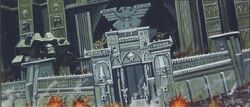
The Traitor Legions lay siege to the Imperial Palace
The siege of Terra by the Traitor forces of Horus began with an orbital bombardment by the Warmaster's fleet as the prelude to invasion. After days of shelling, the Astartes of the Traitor Legions landed on the surface of Terra in Drop Pods and advanced on the two spaceports nearest the location of the Imperial Palace to secure them in preparation for the main landings of the Traitor forces. Elements from five of the Traitor Legions participated in the battle, aided by Traitor forces already on the surface. Despite the brave efforts of the Loyalists, the Eternity Wall and the Lion's Gate Spaceports fell within hours to the Forces of Chaos. With them secured, Horus' remaining troops in the Traitor Legions and their Traitor Imperial Army and Dark Mechanicus support forces landed en masse, and the hulking transports carried thousands of troops each. They also brought to the battlefield the terrible Traitor Titans that served the Warmaster's cause and had been infected with the daemonic spirits of Chaos. The transports' immense size made them prime targets for Terra's defence lasers. Although many of the Traitor landing craft were destroyed in-atmosphere, notably the transport vessel carrying the Legio Damnatus, many more made it to the surface, disgorging yet more soldiers, main battle tanks and Traitor Titans to add to the besiegers' strength. They met stiff resistance from the Loyalists as the Imperial defenders knew that the survival of their homeworld, their Emperor, and the entirety of the human race rested on their shoulders.
The siege of the Imperial Palace then began in earnest. Three times the Forces of Chaos scaled the walls, and three times were hurled back by the defenders. Frustrated at this lack of progress, Horus granted the Legio Mortis the singular honour of breaching the walls of the Imperial Palace, amongst whose defenders were the Loyalist Titans of the Collegia Titanica and their hated rivals -- the Legio Ignatum. Using the many powerful weapons at their disposal, they eagerly set about the task. By virtue of their insane fury they accomplished this near-suicidal endeavour, despite suffering the losses of over thirty Titans in one evening of fierce fighting. The Chaos Warlord-class Titans broke the outer walls and let inwards a flood of Traitors.
But ultimately, the Traitors' assault failed as the final events of the Heresy played out aboard Horus' own flagship, the Vengeful Spirit. The Emperor triumphed during the confrontation between himself and the Chaos-corrupted Warmaster, but only at the cost of his own mortal wounding. The majority of the Traitor Legions scattered following this disastrous defeat, and the Imperial forces gave chase, unleashing the period known as the Great Scouring. Hunted and pursued, system by system, the Chaos Space Marine Traitor Legions and the Traitor Titan Legions eventually were driven into the Eye of Terror and the worlds they had occupied were reconquered by the Imperium.
Post Heresy
Following the Horus Heresy, the Collegia Titanica continued to serve the Adeptus Mechanicus and the Imperium, bringing its might to bear where it was deemed required. Throughout the Heresy, past rivalries between certain Titan Legions were aggravated into outright hatred once they found themselves on opposing sides. For millennia they continued to battle the Traitors at every opportunity, and one of their most significant assignments is bearing vigil over the Eye of Terror and guarding Imperial space from Chaotic raids and Black Crusades. The Collegia Titanica also protects the Imperium from xenos incursions and other threats. Although as a result of their political autonomy as part of the Mechanicus they are generally not concerned with any internal quarrels that may occur between the Imperium's sometimes competing Adepta, they do at times interfere at the behest of their Mechanicus masters, whatever their motives may be.
Notable Campaigns
- Siege of Vraks (813-830.M41) - During the infamous Siege of Vraks, the Legio Astorum Titan battlegroup provided the Imperial 88th Siege Army with its heaviest firepower. Deploying 22 Titans of the Reaver and Warhound-classes, the commitment of this battlegroup in support of the 12th Line Korps was the decisive factor in breaking through the inner defence lines during the Kagori offensive on Vraks Prime. The High Princeps Rand Drauca and the Warp Runners continued to support the campaign on Vraks on numerous occasions, and were heavily engaged again when the Red Scorpions Chapter captured the breach in the central Traitor keep's curtain wall, matching weapons and armour with the Traitor Titans of the Legio Vulcanum I. The exact numbers of enemy Titans was not identified, although post-battle reports claim 14 enemy Warhound and Reaver-class Titans were destroyed during the campaign. As such, the Legio Vulcanum paid a heavy price for its involvement, and the Legio Astorum could claim a famous victory over its ancient enemy.
- The Badab War (912-913.M41) - The Chapter Master of the Astral Claws, Lufgt Huron, the "Tyrant of Badab," sought to have the Badab Sector secede from the Imperium of Man in protest against the Imperium's continued attempts to use the resources of the Badab Sector outside the region rather than dedicating them fully to the defeat of the Forces of Chaos and xenos threats that emerged constantly in the Maelstrom Zone. This major rebellion involved several Space Marine Chapters who turned Renegade and sided with the Tyrant in his mad cause. The world of Angstrom was a highly militant minor Forge World containing a significantly independent Adeptus Mechanicus presence situated at the edge of the Maelstrom Zone, and by this web of kinship the Legio Crucius became involved in the Badab War's savage closing campaigns. The Legio Crucius forces deployed to the siege of Badab Primaris itself, comprised of three full maniples of Titans, some fifteen war machines in all, commanded by the Warlord-class Titan Hell's Daughter and High Princeps Cadmon Krom. The Titans' principal task in the battle was to smash heavy defence points in Badab Primaris' hive cities and industrial zones and crush major pockets of resistance when encountered, a mission they undertook with great relish, fully living up to their Legion's long-standing reputation as savage city-breakers and world burners. The Legio Crucius accounted for untold casualties and devastated the remaining Secessionist heavy armoured forces. The Titan Legion suffered only three losses during the engagement despite the heavy resistance they encountered, and managed to recover all but one of their wrecked Titans in the anarchic retreat from the planet by the Loyalist forces.
- Third War for Armageddon (998.M41) - Ork Warlord Ghazghkull Mag Uruk Thraka launched a second and even more massive Ork WAAAGH! to conquer the Imperial world of Armageddon in 998.M41. As the battles raged on the planet, Ghazghkull unleashed another of his carefully prepared surprises. Incredibly, dozens of Ork Roks (asteroid fortresses) began to descend from orbit. The Roks made landings in the verdant equatorial jungles of the world and across the continents of Armageddon Primus and Secundus. Many were lost to ground fire or accidents but each one that survived became a bastion for the Orks, a rallying point and a ready-made fortress. Besides their formidable armaments, the Roks contained giant teleport arrays. These were employed to teleport down Ork reinforcements, including Gargants and Greenskin heavy artillery, in an endless stream. Commissar Yarrick personally led attacks by regiments of Cadian Shock Troops supported by the Titans of the Legio Ignatum and Legio Metalica, which destroyed several of these fortresses. During a ten-day battle that raged over the Diabolus manufactorum complex and proved to be one of the most fierce of the Third War for Armageddon, Titans from the Legio Crucius engaged the Gargants of the Warlords Burzuruk and Skarfang. Six Titans and eight Gargants were utterly destroyed in the fighting and many others needed months of repairs before they could fight again. The Diabolus complex was wrecked during the battle, its foundries and machine shops blasted apart or crushed underfoot by the giant fighting machines.
- 13th Black Crusade (999.M41) - When the Forces of Chaos assaulted the world of Cadia during the 13th Black Crusade in 999.M41, the Titan Legions stationed on the worlds surrounding the Eye of Terror helped in the defence of that beleaguered Imperial Fortress World. Many other Titan Legions, a number of them unleashing their entire strength, were transferred there to face the Chaotic onslaught.
Organisation
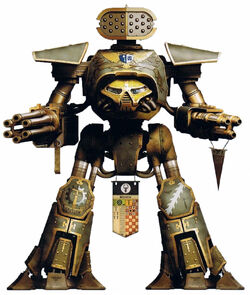
A Reaver-class Titan of the Legio Gryphonicus
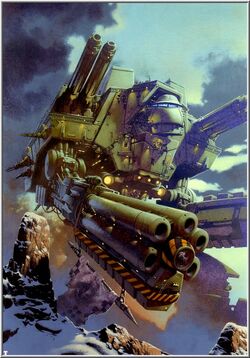
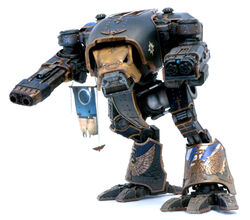
A Warhound-class Titan of the Legio Astorum
The Collegia Titanica is organised into separate Divisiones which each contains a number of Titan Legions (sometimes called "Orders"). A Titan Legion is a group of Titans of different classes under the command of a Grand Master, originating from a common Forge World or worlds. Each is bound by a common heritage, tradition and school of thought, and each possesses a distinctive code of conduct and their own predilection in regard to particular battlefield operation and employed tactics. Each Titan Legion also has a preference for the use of certain weapons, different uniform designs, Titan decorations, rank names, colours, heraldry, and other peculiarities. All of this variety is within certain limits, as Titan Legions may not, for example, change the existing system of ranks and the Collegia Titanica's standard chain of command, though they still possess much liberty in their mode of operation -- similar, in ways, to the Chapters of the Space Marines. Some Titan Legions were created to fulfill specific battlefield roles, such as siege works or combat in special environmental conditions, and thus are geared appropriately, both in terms of equipment and mindset.
The Collegia Titanica is the chief military arm of the Adeptus Mechanicus, and is beholden to that Adepta's ruling Tech-priests. By virtue of the autonomy of the Mechanicus within the broader structure of the Imperium, the Titan Legions answer only to the Tech-priests' hierarchy. Their deployments and assignments are exclusively decided by the Mechanicus' Magi, and each has to be authorised by the ruling lords of a Titan Legion's home Forge World. This right provides the Magi with great influence over when and where Imperial armies making use of Titan support will fight. On the battlefield, Titans may not be issued orders by other commanders, be they Imperial Guard or Space Marine officers. A Titan battlegroup's actions will only be decided by their commanding Princeps, a ranking Magos of the Mechanicus accompanying them, or in some situations by the lords of the Forge World the Titan Legion hails from. Although a high-ranking Tech-priest technically holds authority over a Titan Princeps, as he respects the Princeps' tactical knowledge and experience, the latter would be given much freedom in his actions on the field. The Magos, however, will interfere when he or she deems it necessary, for example ordering the battlegroup to withdraw from a world in order to avoid unnecessary Titan losses. There is one exception to the above -- a member of the Inquisition has the power to commandeer Titans already on the field and directly issue them orders, as well as to requisition the deployment of a Titan battlegroup from a Forge World. However, a wise and politically astute Inquisitor will be careful when interfering in Mechanicus business, and even more so because the Priesthood of Mars is understandably fiercely protective of their Titans.
The number of Titan Legions and individual Titans within the Collegia Titanica is unknown. Yet their ranks are presumed to be large. The Collegia Titanica has many deployments on its hands, protecting the Imperium not only from Traitors, but from xenos forces and other threats as well. Indeed, the Divisio Militaris deploys over a hundred Titan Legions to watch over the Eye of Terror alone, and the galaxy harbours many more threats to humanity that require the attention of the Titan Legions. In addition to these duties, the Titan Legions also take on expeditions which lead them away from the boundaries of the Imperium -- bringing new worlds into the Imperial fold, aiding Rogue Traders and Adeptus Mechanicus Explorator fleets.
The number of Titans in a single Legion varies greatly, as some possess as few as a dozen, and others maintain over a hundred. Battle losses take decades or even centuries to replace, as the construction of a new Titan is a long and extremely labourious process for the Adeptus Mechanicus. The Warlord-class is the most commonly found class of Battle Titan amongst the forces of the Imperium, while the Warhound is the smallest, utilised for scouting and flanking purposes. Between them stands the Reaver-class Battle Titan. The towering Emperor Battle Titans, the size of great Imperial cathedrals, are by far the most formidable types of Titans ever deployed by the Imperium, but an increasingly rare sight on the battlefields of the 41st Millenium. Titan Legions are deployed only in the most vital campaigns of the Imperium and on battlefields that will allow them to unleash the full power of their colossal weaponry.
Operation
Over the long millennia of constant warfare, the Legions of the Collegia Titanica have developed their own tried and tested tactics and battle formations, many of which are based around the unit known as the "maniple". This is a configuration that makes use of Reaver- and Warhound-class Titans, consisting of at least three machines. In a maniple formation, the Warhounds stride ahead of the Reavers, finding and marking targets to be destroyed by the advancing Titans. Some Titan battlegroups are in fact only maniples, and if such a force faces the need to divide its strength, it will create smaller units of near-identical configuration called demi-maniples.
The Tech-priests accompanying a Titan battlegroup carry with them the equipment necessary to accommodate Titans engaged in heavy combat, and in addition to the performance of mundane battlefield maintenance, have the means to conduct minor field repairs. The Tech-priests can facilitate the rearming of Titans in the event of the destruction of their original weapons load-out, or refit them with ordnance better suited for the task they face when battlefield conditions change.
Damaged Titans are taken after battle to the Tech-priests' facilities for repairs, but if during the course of fighting one of them sustains grave damage it will be withdrawn as soon as possible so as to avoid its untimely destruction, and given into the care of the Tech-adepts. If they prove unable to assuage the battered machine's pain, they will secure the ravaged Titan and return it to their home Forge World, where it may be given appropriate care. Despite such precautions, the God Machines occasionally do fall in combat, much to the grief of the Cult Mechanicus and in particular the crews and staff that accompanied them. When a campaign is running its course, although saddened, the Forge World will send new Titans to replace the battlefield losses and to continue the fight.
The Divisiones
The Collegia Titanica has four Divisiones, the Divisio Mandati, the Divisio Telepathica, the Divisio Investigatus, and most importantly, the Divisio Militaris, which is the main fighting force of the Collegia Titanica. The Divisiones are further divided into a number of "Legions" or "Orders": groupings of Titans bound by a common heritage such as the Legio Ignatum or the Legio Gryphonicus. Each Titan Legion is a self-contained unit headed by an officer with the rank of Grand Master.
Divisio Militaris
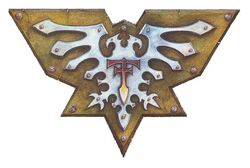
Badge of the Divisio Militaris
The Titan Legions of the Divisio Militaris (or as it is more commonly called, the Military Orders) are the main military force of the Collegia Titanica, and each includes its own support staff in addition to its Titans. Each Legion is based on its own Adeptus Mechanicus Forge World -- most Forge Worlds maintaining one, though others are known to harbour a larger number -- with Mars itself having three. Although their home Forge Worlds are technically their bases, the Titan Legions are actually stationed throughout the galaxy, guarding vulnerable locations across the Imperium. Many Legions are stationed near the Eye of Terror, ready to combat their Chaotic counterparts. Some of the Military Orders are highly specialised forces, created to deal with siege works or combat in exotic planetary environments.
Divisio Mandati

Badge of the Divisio Mandati
The Titan Legions of the Divisio Mandati are known as "Executive Orders." They travel in vast temple-spacecraft, responsible for bringing the Pax Imperia to isolated worlds of the Imperium. Each temple ship carries between two and five of the immense Emperor Battle Titans, as well as Tech-priests, Mechanicus regular troops, maintenance Adepts and support personnel.
Each Emperor Titan in the Divisio is its own self-contained unit, carrying members of the Adeptus Arbites, the Inquisition and the other Adepta of the Adeptus Terra. With an Emperor Titan as their platform, servants of the Imperium can be very persuasive, and if that fails, they possess more than enough firepower to get their point across. It is through this combination of persuasion and potent threat that the Pax Imperia is brought to many worlds.
Some of the Executive Orders never leave the boundaries of Imperial space, confined to the dioceses left to their care. The elite of the Divisio Mandati's Titan Legions are known as "Missionary Orders" -- they travel beyond the borders of the Imperium, often accompanying Rogue Traders in discovering new worlds and regions of space to be settled and exploited by Mankind.
Divisio Telepathica

Badge of the Divisio Telepathica
Being highly specialised, the Divisio Telepathica is somewhat smaller than the Divisiones Mandati and Militaris. The Divisio Telepathica is responsible for the operation of the dreaded Psi-Titans, whom, judging by their known deployments, are specially designed to combat the Forces of Chaos and the Traitor Titan Legions. Its Legions are called the "Telepath Orders", each operating from a secret Forge World near the heart of the Imperium. The existence of Chaos is a closely held secret of the Imperium, as are all those organisations like the Ordo Malleus and the Grey Knights devoted to combating it. Since nearly nothing is known of the Divisio Telepathica, and because of their presumed dedication to combating the Ruinous Powers, it is not unlikely that it ranks alongside those esteemed servants of the Imperium as being entirely unknown by the greater populace of the galaxy.
Divisio Investigatus

Badge of the Divisio Investigatus
The Divisio Investigatus is the scientific research and development division of the Collegia Titanica. Its role is to construct the many war engines used by all the Titan Legions, and to engineer and test the rare improvements made in Titan technology by the increasingly stagnant Imperium. At times, a Research Order takes part in battle so that it can test its new designs under proper combat conditions. The Divisio Investigatus' Titan Legions favour the Warlord-class Titans, as their well-known handling characteristics and capabilities make them an ideal test-bed for the Divisio's new devices.
The Warriors of the Collegia Titanica
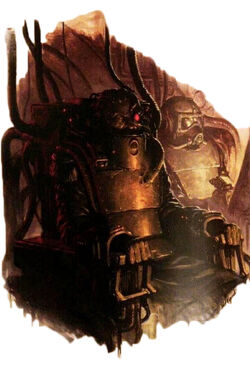
A High Princeps of the Legio Astorum on the command bridge of his Reaver-class Titan
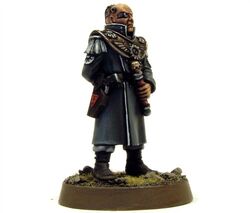
A Titan Princeps
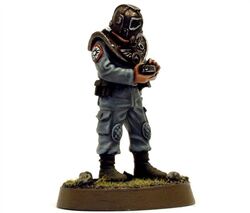
A Titan Moderatus
Titan crews are ranked alongside the elite of the Imperial Navy in the skill and with which they operated their mighty engines of war, although compared to the crews of void-faring warships they were few in number indeed. The Princeps is in total command of the Titan via a mind impulse unit, a complex and not entirely understood device that merges body and mind with that of the engine so completely that a princeps controls the Titan's metal form as they would their own flesh. The process is a two-way one however, for each Titan, in particular the more ancient machines, is invested of its own individual anima which is the product of its deeds and its former masters, and which bleeds into the consciousness of the princeps to create a gestalt of the two. So immersive is this connection that should the Titan suffer damage, the princeps feels it as if their own flesh were wounded. Severe damage is likely to cause crippling stigmata on the princeps' body, and should the engine be dealt a killing blow, the cyber-neural feedback is almost certain to kill them.
Assisting the princeps are a number of specialist crew, the exact number and their roles dependent on the class of Titan as well as the doctrines of the parent Legio. These are known as "Moderati", and each has responsibility for a different system, such as the sensors or the helm, adding their own oversight towards the mind impulse commands of the princeps. Several of these moderati are stationed at the princeps' side within the "head" of the god-engine, while others are located elsewhere in the Titan's mighty form-the gun moderati, for example, are often stationed in the carapace as near to their weapons as the Titan's complex anatomy allows. In addition, one or more Tech-Priests watch over the god-engine's mighty plasma generator, assisted by a small cadre of servitors. While a lighter class of Titan, such as a Warhound, might have but a handful of crew, a Warlord might have a dozen and an Imperator even more.
As a result of the battles they come through together and because of their link to their Titan's Mind Impulse Unit, Princeps and Moderati are often more closely knit than families. Being linked to the MIU can also be dangerous and even lethal, as the potent Machine Spirit of a Titan can wreck an unprepared individual's conciousness and drive them to madness. Damage to the system's circuitry can cause the MIU to go haywire, and in such circumstances, the luckiest are killed instantly by the psychic shock, while the rest are reduced to gibbering lunatics. Most of the crews' MIU's are equipped with manual emergency cut-offs, however, sometimes the Moderati and Princeps are not able to utilise them quickly enough to avoid the damage. MIU links are attached via implanted socket connectors in the cranium and neck, or in the body armour the crew wear. The armour's role is to shield them from secondary damage caused by shrapnel and impacts, and it additionally contains power and life support units, also attached by umbilicals to external devices. These umbilicals have many redundant channels, so that if any one is severed in the heat of battle, another can easily take its place, making sure that nothing impedes the crew's ability to fight.
Tech-Priests
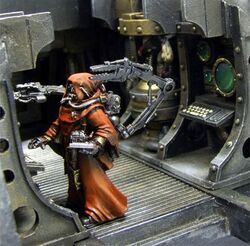
A Titan Tech-priest attending to his war machine
Tech-priests are charged with maintaining the Titan during the course of a battle, monitoring the state of the unstable and dangerous plasma reactor which is used to satiate the great machine's colossal power requirements, making sure that there is enough output to operate as many systems as possible, and that a catastrophic meltdown does not occur. In addition, the Tech-priest will tend to other devices present on the Titan, guaranteeing that they function to their best ability. Amongst those devices are the Void Shield generators, which are a Titan's first line of defence. In the process of deflecting and absorbing hits, the generators build up a large excess of power, which eventually will cause them to shut down to prevent damage. A Tech-priest will attempt to withdraw as much as possible, at the same time carefully monitoring the reactor, so that the Titan does not take a direct hit. However, when the Void Shields fail, the God Machine sustains structural damage. In such an event, the Tech-priest will immediately make sure that the reactor does not threaten meltdown, attempt to bring the Void Shield generators back on line, and then scan the Titan, searching for systems which have been disabled by damage, and try to repair them. In all these tasks, the Tech-priest is assisted by a number of Servitors hard-wired into the machine.
Reverence
To the Cult Mechanicus, Titans are incarnations of the Machine God in the material realm, and possess a sacredness invested in them by virtue of their antiquity and technical complexity. The Tech-Priests proclaim their divine nature by word and ritual. A thousand times blessed and consecrated with the holiest unguents, a Titan is a towering, walking idol to the Tech-priests of the Machine God. Many see the honour of serving aboard a Titan as an opportunity to serve the Omnissiah in person, and there is no greater service a mere mortal can perform.
Prior to being sent into battle, ceremonies are performed and the war engines are blessed. Exotic creatures are slain and their blood used to annoint each Titan's foot -- a symbol of the reality that they will soon lay blood at the Emperor's feet. During these rituals a senior Tech-priest will sprinkle the machine with sanctified oils and recite passages of the Prima Incubatoria. These rites serve to rouse the Titan's Machine Spirit and prepare it for battle. A holy engine of destruction, a Titan's death is greatly saddening to all in the Cult Mechanicus. When one of their number falls, the rest will attempt to recover its ravaged hull and send it to their home Forge World, which will mourn its passing and toll a bell for each Titan lost.
Heraldry
Each Titan bears a distinctive and unique set of symbols. The Titan Legions use a complex and largely archaic system of decorations, icons and insignia to record a machine's past, as well as dedicating its Machine Spirit to the Emperor. Amongst those are banners flown from the Titan as well as markings and heraldry etched on the Titan's hull. The following specifications lay out a minimum standard followed by much of the Collegia Titanica. However, every Titan Legion, and to lesser extent individual machines and their crews, have much freedom in designing their own decorations.
Crew Badges and Uniforms
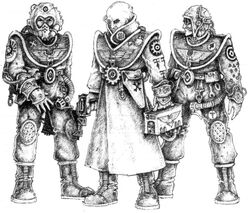
A Princeps flanked by two Moderati

Princeps rank badge

Senior Princeps rank badge
The uniforms and insignia of a Titan crew are largely specific to a given Titan Legion, as they are entitled to create their own designs. The body armour worn by Titan crewmen, in addition to granting protection, only has to accomodate two functions -- to allow for a cybernetic link to the Mind Impulse Unit, and to contain the necessary power and life support systems. Usually, a crewmember's rank badge will be displayed on his left shoulder, whereas the Titan Legion badge will be shown on the right. Some Legions also use a chest badge, and the symbol of a crewmember's rank will be attached to or hanging on a short chain from it. Personal decorations are not uncommon, especially amongst Moderati who mark their kills on their left sleeves. It is also common practise for Princeps to add their Titan's honours to their uniform. Some Titan Legions, however, choose not to display any decorations and insignia on their uniforms, believing that the markings their Titans bear convey all the required information.
Ranks
Titan crewmen, save for the war machines' attendant Tech-priests, are divided into four ranks. These are, in order of seniority, the Moderatus, the Princeps, the Senior Princeps, and the Titan Legion's Grand Master. Although such an event would be rather unlikely, in theory a Moderatus can advance through the ranks and one day become a Grand Master himself. The Moderatus rank badge is in the shape of a plain circle surrounding a hollowed-out geometric figure -- if the Order the crewman belongs to utilises chest badges, in the amulet attached to it this shape will be socketed with a phased crystal gem which is used as a key to the Titan's controls. The Princeps and Senior Princeps also bear similar insignia, however the circles around their socketed gems have lugs added -- four and twelve, respectively. A Grand Master's rank badge is unknown. However, when one takes to the field aboard his Titan and wishes to make his presence apparent, he is entitled to fly a banner bearing his Divisio's symbol. Some Legions use different names for these ranks, though none is entitled to change the system itself -- for example, some Titan Legions designate a Senior Princeps as a "High Princeps."
Hull Markings
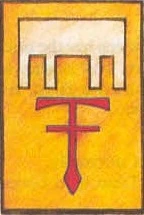
A Warhound-class Titan identification mark
Titan hulls are richly inscribed and decorated, as befits these physical avatars of the Omnissiah. This grows more true over time, as they are awarded honours for their performance on the battlefield, and their crews never miss an opportunity to etch a new commendation on the machine. The war engines also bear the personal heraldry of their Princeps. In the event of their death, the old commander's emblem would be removed and the new one's painted in its place. The standard place for these heraldic sigils are, for Reaver-class Titans, the kneeplates, or for Warhound-class Titans, the carapace or leg plates. Although the colour scheme is constant for all Titans in a Legion, the decorations they bear are not. Machines of similar names (e.g Canis Primus, Canis Secundus) will bear similar decorations, however, since those are very much the indication of the individual Titan, no two can be exactly alike. The war engine's head will often be incribed with the name of the Titan, or, barring that, the name of its Legion. The hull will also display a gilded dedication to the Emperor, along with the Purity Seals the machine has earned during its service.
Titans can also be seen bearing identification marks. They are symbols etched on the Titan's legs where they can be clearly seen by ground level troops and provide them with information on what class of a Titan is towering over them. The Warhound identification mark is a rectangular shape standing on four unevenly spaced vertical legs, the Reaver mark is an axe facing leftwards, and the Warlord mark is two crossed axes. Imperator-class Titan identification marks are presently unlisted in Imperial records.
Banners
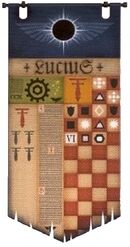
Legio Astorum Princeps Honour Banner
The banners flown from the Titan contain much information on its origin, history and feats, its past and present, the information essential to what the Titan is. These banners are very much prized Imperial relics in their own right, and will be taken down from the machines to which they belong prior to battle in order to preserve them. This means that for most of the time, the banners are stored on the Titan Legion's homeworld, or follow the Titans on their deployments to warzones stashed safely behind the front lines in the resupply and refit facilities set up by the Tech-priests accompanying the war machines.
Honour Banners
The Honour Banner is the most prominent banner flown from a Titan, bearing the symbol of the Legion it belongs to and displaying the rank of the Princeps in command of it. It also usually displays the individual Titan's honours and battles won. The Honour Banner has the following form: it is split into two horizontal bands on the top of the Banner, the rest being split into two vertical bands of equal size. The left vertical band is further split in a similar fashion, one horizontal band on top and two vertical bands below. The larger horizontal bands bear, top to bottom, the emblem of the Titan Legion the machine belongs to, and the name of its home Forge World. Some Titan Legions, however, choose to display the Legion's name instead, and some individual Titan banners can be seen displaying their revered machine's name altogether. Further, the right vertical band contains a listing of the battles the Titan participated in and won (likely under its current Princeps), broken down by the type of enemy they faced – these markings being entirely invented by a given Legion. On the left vertical band, the top horizontal section displays the rank of the Princeps in command of the Titan, as well as recording past Princeps, if only by number. On the leftmost vertical band, the Titan's individual honours are listed in the form of arrayed "T" symbols. The vertical section located to the right contains a High Gothic litany of deliverance from danger, and dedicates the war engine to the Emperor.
Kill Banners

Legio Astorum Moderatus Kill Banner
The Kill Banner displays the Titan-class kills attributable to the actions of an individual Moderatus. The Kill Banner usually takes the shape of a triangle, with a top section bearing decoration used to differentiate each Moderati's banner, and the lower section listing the kills -- usually in the form of skulls. If there is only one Gun Moderatus aboard a Titan, only one banner will be flown. The Moderati religiously mark their feats on their banners, as a form of service to the Titan, and in extension, to the Machine God.
Heresy Banners

Legio Gryphonicus Heresy Banner
During the dark days of the Horus Heresy, fully half of the Collegia Titanica's Titan Legions declared their allegiance to the rebel Warmaster Horus in his bid for power over Mankind. Those Titans that have remained loyal to the Emperor during that grim time -- and survived -- gained the right to fly Heresy Banners, as a display of their steadfast loyalty to the Imperium. The banner, in addition to decoration specific to a given Titan Legion, bears the Divisio Militaris eagle, the Legion's campaign motto, citations and honours from battles the Titan has taken part in, and purity seals it has been awarded during this period.
Known Loyalist Titan Legions
- Firesword Legion
- Imperial Eagles
- Imperial Fists (Titan Legion)
- Imperial Hunters
- Legio Adamantus
- Legio Aeris Aestus
- Legio Agravides (Battle Scourges)
- Legio Annihilator
- Legio Astorum (Warp Runners)
- Legio Astraman (Morning Stars)
- Legio Atarus (Firebrands)
- Legio Castigatum
- Legio Crucis
- Legio Crucius (Warmongers)
- Legio Debellator
- Legio Decimata
- Legio Destructor (Beasts of Steel)
- Legio Ferrax (Iron Wolves)
- Legio Fortidus
- Legio Gigantes
- Legio Gladius
- Legio Gryphonicus (War Griffons)
- Legio Honorum (Deathbolts)
- Legio Ignatum (Fire Wasps)
- Legio Ignis (Fire Kings)
- Legio Interfectra
- Legio Intrafex
- Legio Invicta
- Legio Invigilata (Emperor's Guard)
- Legio Lacrimae
- Legio Lysanda (Sentinels of the Edge)
- Legio Maledictus
- Legio Manus Flameaus
- Legio Metalica (Iron Skulls)
- Legio Mortis Metallum
- Legio Nivalis (Ice Giants)
- Legio Oberon (Death Bolts)
- Legio Ordo Canis
- Legio Osedax (Cockatrices)
- Legio Pallidus Mor (Pale Riders)
- Legio Perennia
- Legio Praesagius (True Messengers)
- Legio Praetor
- Legio Sirius
- Legio Tempestus (Stormlords)
- Legio Tenerii
- Legio Thanataris
- Legio Ultima
- Legio Venator (Iron Spiders)
- Legio Vindictus
- Legio Victorum (Foe Slayers)
- Legio Xerxes
- Nova Guard
- Ordo Sinister (Nightmare Titans)
Known Traitor Titan Legions
- Adamant Fury
- Burning Stars
- Death Stalkers
- Forsaken Reavers
- Iron Skulls
- Legio Argentum
- Legio Audax (Ember Wolves)
- Legio Convenentia
- Legio Damnatus (Warped Dogs)
- Legio Damnosus (Lords of Ruin)
- Legio Excruciatus (Helldogs)
- Legio Fureans (Tiger Eyes)
- Legio Interfector (Murder Lords)
- Legio Krytos (God Breakers)
- Legio Kydianos (Death Cry)
- Legio Lacrymea (Harbingers of Grief)
- Legio Magna (Flaming Skulls)
- Legio Metallum Armaturum
- Legio Mordaxis
- Legio Mortis (Death's Heads)
- Legio Serpentes
- Legio Suturvora (Fire Masters)
- Legio Tempestor (Storm Lords)
- Legio Ulricon
- Legio Vulcanum I (Dark Fire)
- Legio Vulcanum II (Lords of Ruin)
- Legio Vulpa
- Legio Vulturum (Gore Crows)
- Legio Xestobiax (Iron Vigil)
Sources
- Adeptus Titanicus (1st Edition), pp. 2, 5, 6-7, 18, 29, 51
- Codex: Eye of Terror (3rd Edition), pg. 16
- Codex Titanicus (1st Edition), pp. 4, 7, 13, 15, 18, 22-23, 26-27, 30
- Imperial Armour Volume Three - The Taros Campaign, pg. 251
- Imperial Armour Volume Six - The Siege of Vraks - Part Two, pp. 34-35, 42, 48, 53, 60, 79, 83-84, 112-113, 118, 199
- Imperial Armour Volume Seven - The Siege of Vraks - Part Three, pp. 37, 49, 88, 205-206
- Imperial Armour Volume Ten - The Badab War, Part Two, pp. 44, 50
- Imperial Armour Volume Eleven - The Doom of Mymeara, pp. 18-19, 36, 39, 50-51, 56, 106
- Imperial Armour Update 2006, pg. 5
- Imperial Armour Apocalypse II, pg. 39
- Titan Legions (2nd Edition), pp. 11-16, 19
- Warhammer 40,000: Apocalypse, pg. 124
- Warhammer 40,000: Rulebook (4th Edition), pg. 121
- Mechanicum (Novel) by Graham McNeill
- The Horus Heresy: Collected Visions by Alan Merett, pp. 354-362
- Third War for Armageddon Worldwide Campaign

